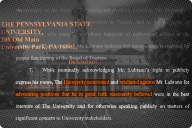You have /5 articles left.
Sign up for a free account or log in.

University of Nebraska - Lincoln
The Institution: University of Nebraska-Lincoln
The Problem: Nebraska-Lincoln learned its online-only Educational Administration graduate students felt isolated and had trouble connecting with faculty members and staff, and that all new Education Administration graduate students, in general, had trouble meeting the rigors of the program. In a survey, online students also said that information on-campus students pick up through informal chats with peers, faculty members and staff was hard to obtain. Fully online students make up two-thirds of the program’s 423 learners.
The Goal: To expand the orientation program to meet its online students’ needs, from the first month of classes through degree completion. “We wanted our students who never step foot on campus to feel more connected to our department,” said Brian C. Wilson, an instructional design technology specialist.
Besides connecting with faculty members and staff, the department sought to help the online graduate students:
•Learn the basics about the university, such as how to create an email account, register for classes, and how to use their Nebraska-Lincoln ID number.
• Understand the Educational Administration program requirements.
• Recognize the expectations of graduate work and how those expectations differ from undergraduate work.
• Learn how to use the services offered by the library and writing center remotely.
The Experiment: Wilson and assistant professor Christina W. Yao created the online EDAD Student Success Center that includes not only answers to basic orientation questions that all new students need to know, but also expertise from library and writing center officials.
In the center, library officials explain to online students how to access research databases, how to manage citation management, and even how to get books mailed to them if needed. “Even though she’s been a professor at Nebraska-Lincoln for three years, Yao admitted she had “no idea” what services the library offered.
Wilson and Yao said Nebraska-Lincoln has two types of online graduate students: learners who just completed undergraduate degrees, but who are often unaware of the increased rigor in graduate studies, and students who have been out of college for 10 years or more and who need to understand that accessing information from a un college library has changed drastically. A tutorial in the center explains the services a student can get from the library, and also how to contact a subject librarian.
Meanwhile, Wilson and Yao quickly realized there was no mechanism for the writing center to help online students The center agreed to revamp its operations to work with online students.The video section of the center might be the most popular. To better connect online students with instructors, Wilson and Yao had faculty members record a short video to introduce themselves, talk about their roles in the department and provide some advice, such as practical tips about study habits and graduate school life.
What Worked (and Why): The Success Center, which launched in the fall of 2016, took about six months and less than $100 to create, Wilson said. When the center was complete, Wilson and Yao knew it provided a lot of useful information for students, but they also knew their efforts wouldn’t matter if they couldn’t get students to use the site. Wilson said the Success Center had to be “compelling enough to use” because it’s not required.
Yao said she and some instructors assigned students to use the center as part of an for-credit assignment. The hope was that getting students familiar with its benefits would entice them to return often. It worked: Page views range from 30 per day all the way to 600, with the heaviest traffic near the start of each term.
In the short time since the site launched, feedback has been positive. Faculty and staff like the site so much that they suggested opening the center to all graduate students in the program not just online learners. A preliminary survey showed that nearly 60 percent of the students who responded strongly agreed or agreed that the center was easy to navigate. Students identified the library resources and the faculty videos as the most helpful parts of the site.
 Two comments from students on different ends of the spectrum showed the center’s promise. Adam Fullerton, a Ph.D. student in his first semester, called the center “essential in my first weeks of the program.” An anonymous fourth-semester student commended the library tutorial. “I enjoyed the simplicity and intuitive nature of the presentation. I only wish I had experienced this earlier in my academic career here.”
Two comments from students on different ends of the spectrum showed the center’s promise. Adam Fullerton, a Ph.D. student in his first semester, called the center “essential in my first weeks of the program.” An anonymous fourth-semester student commended the library tutorial. “I enjoyed the simplicity and intuitive nature of the presentation. I only wish I had experienced this earlier in my academic career here.”
What Didn’t (and Why): It quickly became obvious that online graduate students wanted a place to connect with each other. While many suggested the Success Center would be the natural place, Yao and Wilson aren’t quite sure how to add this functionality to the site.
“We’re thinking about how to do this,” Yao said. But, she said, she worries that staff and faculty members don’t have time to monitor the discussions of 280 students.
While the professor videos have turned out to be a highlight of the site, getting all of them to agree to go on camera wasn’t easy. “We have some fantastic professors who don’t have a problem being themselves in a classroom, but a camera can make them nervous,” Wilson said.
“We were able to wear them down,” through a combination and cajoling, Yao said, adding she was a human teleprompter when needed and faculty members were allowed to redo their videos if necessary.
Finally, the survey showed that several students were requesting information that’s available on the site, so Yao and Wilson plan to improve labeling.
Next Steps: “This is still a growing thing,” Wilson said. “We want it to become part of the department’s culture.” As faculty members become more familiar with the site, Wilson expects them to request more information be made available to online students.
While it made sense to start the Success Center in the Educational Administration department because it has one of the university’s largest distance student enrollments, Yao said she would not be surprised to see other departments at Nebraska-Lincoln replicate the concept for their online students. “There are different people at the university interested in this. Distance learning is not slowing down,” Yao added.








